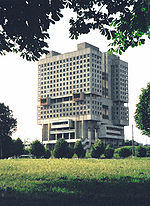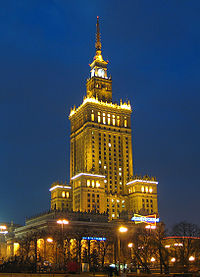
Lev Rudnev
Encyclopedia
Lev Vladimirovich Rudnev was a Soviet architect
, and a leading practitioner of Stalinist architecture
.
(other sources state Novgorod). He graduated from the Riga
Realschule
(now the Riga 1st State Grammar School) and entered the Imperial Academy of Arts
in Saint Petersburg
(1906). At the Academy he studied painting under Leon Benois
and architecture under Ivan Fomin
. From 1911 Rudnev was a success in various architectural competitions, and in 1915 he became a certified specialist in the art of architecture.
After the February Revolution
Rudnev won the competition for the Victims of the Revolution monument on the Field of Mars
in Petrograd (March 1917). The avant-garde monument there was built according to his design.
After the end of the Second World War, Lev Rudnev took active part in reconstructing the ruined cities of Voronezh
, Stalingrad
, Riga
and Moscow
. In 1922-1948 Rudnev was a Professor of the Academy of Arts (former Imperial Academy of Arts) in Leningrad; in 1948-1952 he was a Professor at the Moscow Institute for Architecture (Moskovskij Arkhitekturny Institut). Rudnev was also a member of Soviet Academy of Architecture.
Rudnev’s most remarkable architectural work is the ensemble of the Lomonosov Moscow State University
on Vorobyovy (then Lenin’s) Hills (1948–1953, co-designed with S. Chernyshov, P. Abrosimov, A. Khryakov, and engineer V. Nasonov). His Palace of Culture and Science in the centre of Warsaw
in Poland (1952-1955) resembles the markedly sculptural style of the MSU ensemble.
He was the author of many large scale Soviet
projects, including:
|+ Photos
|width="25%"|
|width="25%"| |width="25%"|
|width="25%"|
|width="25%"| |-
|-
|Frunze Military Academy in Moscow (1939)
|House of the Government of the Azerbaijan Soviet Socialist Republic in Baku
|The main building of Moscow State University
.
|Palace of Culture and Science, Warsaw
|}>
Architect
An architect is a person trained in the planning, design and oversight of the construction of buildings. To practice architecture means to offer or render services in connection with the design and construction of a building, or group of buildings and the space within the site surrounding the...
, and a leading practitioner of Stalinist architecture
Stalinist architecture
Stalinist architecture , also referred to as Stalinist Gothic, or Socialist Classicism, is a term given to architecture of the Soviet Union between 1933, when Boris Iofan's draft for Palace of the Soviets was officially approved, and 1955, when Nikita Khrushchev condemned "excesses" of the past...
.
Biography
Rudnev was born to the family of a school teacher in the town of OpochkaOpochka
Opochka is a town and the administrative center of Opochetsky District of Pskov Oblast, Russia, located on the Velikaya River, south of Pskov, in the proximity of Alexander Pushkin's family home Mikhaylovskoye. Population:...
(other sources state Novgorod). He graduated from the Riga
Riga
Riga is the capital and largest city of Latvia. With 702,891 inhabitants Riga is the largest city of the Baltic states, one of the largest cities in Northern Europe and home to more than one third of Latvia's population. The city is an important seaport and a major industrial, commercial,...
Realschule
Realschule
The Realschule is a type of secondary school in Germany, Austria, Switzerland, and Liechtenstein. It has also existed in Croatia , Denmark , Sweden , Hungary and in the Russian Empire .-History:The Realschule was an outgrowth of the rationalism and empiricism of the seventeenth and...
(now the Riga 1st State Grammar School) and entered the Imperial Academy of Arts
Imperial Academy of Arts
The Russian Academy of Arts, informally known as the St. Petersburg Academy of Arts, was founded in 1757 by Ivan Shuvalov under the name Academy of the Three Noblest Arts. Catherine the Great renamed it the Imperial Academy of Arts and commissioned a new building, completed 25 years later in 1789...
in Saint Petersburg
Saint Petersburg
Saint Petersburg is a city and a federal subject of Russia located on the Neva River at the head of the Gulf of Finland on the Baltic Sea...
(1906). At the Academy he studied painting under Leon Benois
Leon Benois
Leon Benois was a Russian architect. He was the son of architect Nicholas Benois, the brother of artists Alexandre Benois and Albert Benois, and the grandfather of the actor Sir Peter Ustinov...
and architecture under Ivan Fomin
Ivan Fomin
Ivan Aleksandrovich Fomin was a Russian architect and educator. He began his career in 1899 in Moscow, working in the Art Nouveau style. After relocating to Saint Petersburg in 1905, he became an established master of the Neoclassical Revival movement...
. From 1911 Rudnev was a success in various architectural competitions, and in 1915 he became a certified specialist in the art of architecture.
After the February Revolution
February Revolution
The February Revolution of 1917 was the first of two revolutions in Russia in 1917. Centered around the then capital Petrograd in March . Its immediate result was the abdication of Tsar Nicholas II, the end of the Romanov dynasty, and the end of the Russian Empire...
Rudnev won the competition for the Victims of the Revolution monument on the Field of Mars
Field of Mars (Saint Petersburg)
The Field of Mars or Marsovo Polye is a large park named after the Mars - Roman god of war situated in the center of Saint-Petersburg, with an area of about 9 hectares. Bordering the Field of Mars to the north are the Marble Palace, Suvorova Square and Betskoi’s and Saltykov’s houses. To the west...
in Petrograd (March 1917). The avant-garde monument there was built according to his design.
After the end of the Second World War, Lev Rudnev took active part in reconstructing the ruined cities of Voronezh
Voronezh
Voronezh is a city in southwestern Russia, the administrative center of Voronezh Oblast. It is located on both sides of the Voronezh River, away from where it flows into the Don. It is an operating center of the Southeastern Railway , as well as the center of the Don Highway...
, Stalingrad
Volgograd
Volgograd , formerly called Tsaritsyn and Stalingrad is an important industrial city and the administrative center of Volgograd Oblast, Russia. It is long, north to south, situated on the western bank of the Volga River...
, Riga
Riga
Riga is the capital and largest city of Latvia. With 702,891 inhabitants Riga is the largest city of the Baltic states, one of the largest cities in Northern Europe and home to more than one third of Latvia's population. The city is an important seaport and a major industrial, commercial,...
and Moscow
Moscow
Moscow is the capital, the most populous city, and the most populous federal subject of Russia. The city is a major political, economic, cultural, scientific, religious, financial, educational, and transportation centre of Russia and the continent...
. In 1922-1948 Rudnev was a Professor of the Academy of Arts (former Imperial Academy of Arts) in Leningrad; in 1948-1952 he was a Professor at the Moscow Institute for Architecture (Moskovskij Arkhitekturny Institut). Rudnev was also a member of Soviet Academy of Architecture.
Rudnev’s most remarkable architectural work is the ensemble of the Lomonosov Moscow State University
Moscow State University
Lomonosov Moscow State University , previously known as Lomonosov University or MSU , is the largest university in Russia. Founded in 1755, it also claims to be one of the oldest university in Russia and to have the tallest educational building in the world. Its current rector is Viktor Sadovnichiy...
on Vorobyovy (then Lenin’s) Hills (1948–1953, co-designed with S. Chernyshov, P. Abrosimov, A. Khryakov, and engineer V. Nasonov). His Palace of Culture and Science in the centre of Warsaw
Warsaw
Warsaw is the capital and largest city of Poland. It is located on the Vistula River, roughly from the Baltic Sea and from the Carpathian Mountains. Its population in 2010 was estimated at 1,716,855 residents with a greater metropolitan area of 2,631,902 residents, making Warsaw the 10th most...
in Poland (1952-1955) resembles the markedly sculptural style of the MSU ensemble.
He was the author of many large scale Soviet
Soviet Union
The Soviet Union , officially the Union of Soviet Socialist Republics , was a constitutionally socialist state that existed in Eurasia between 1922 and 1991....
projects, including:
- Frunze Military Academy in Moscow (1939)
- administrative building on Shaposhnikov street (1934-1938)
- administrative building on Frunze embankment (1938-1955)
- the main building of Moscow State UniversityMoscow State UniversityLomonosov Moscow State University , previously known as Lomonosov University or MSU , is the largest university in Russia. Founded in 1755, it also claims to be one of the oldest university in Russia and to have the tallest educational building in the world. Its current rector is Viktor Sadovnichiy...
(1949-1953). This is probably the best known of his buildings, for which he was awarded the Stalin Prize in 1949 - House of the GovernmentGovernment House, BakuThe Government House of Baku, also known as House of Government, is a government building housing various state ministries of Azerbaijan. It is located on Neftchiler Avenue and faces the Baku Boulevard. The rear side of the building faces busy Uzeyir Hajibeyov Street of central Baku...
of the Azerbaijan Soviet Socialist Republic in BakuBakuBaku , sometimes spelled as Baki or Bakou, is the capital and largest city of Azerbaijan, as well as the largest city on the Caspian Sea and of the Caucasus region. It is located on the southern shore of the Absheron Peninsula, which projects into the Caspian Sea. The city consists of two principal...
(finished in 1952) - Palace of Culture and Science in WarsawWarsawWarsaw is the capital and largest city of Poland. It is located on the Vistula River, roughly from the Baltic Sea and from the Carpathian Mountains. Its population in 2010 was estimated at 1,716,855 residents with a greater metropolitan area of 2,631,902 residents, making Warsaw the 10th most...
in PolandPolandPoland , officially the Republic of Poland , is a country in Central Europe bordered by Germany to the west; the Czech Republic and Slovakia to the south; Ukraine, Belarus and Lithuania to the east; and the Baltic Sea and Kaliningrad Oblast, a Russian exclave, to the north...
(1952-1955) - buildings of Latvian Academy of SciencesLatvian Academy of SciencesThe Academy of Sciences is the official science academy of Latvia and is an association of the country's foremost scientists. The academy was founded as the Latvian SSR Academy of Sciences . It is located in Riga...
in RigaRigaRiga is the capital and largest city of Latvia. With 702,891 inhabitants Riga is the largest city of the Baltic states, one of the largest cities in Northern Europe and home to more than one third of Latvia's population. The city is an important seaport and a major industrial, commercial,...
(1953-1956)
|width="25%"|
|width="25%"|

|width="25%"|

|Frunze Military Academy in Moscow (1939)
|House of the Government of the Azerbaijan Soviet Socialist Republic in Baku
Baku
Baku , sometimes spelled as Baki or Bakou, is the capital and largest city of Azerbaijan, as well as the largest city on the Caspian Sea and of the Caucasus region. It is located on the southern shore of the Absheron Peninsula, which projects into the Caspian Sea. The city consists of two principal...
|The main building of Moscow State University
Moscow State University
Lomonosov Moscow State University , previously known as Lomonosov University or MSU , is the largest university in Russia. Founded in 1755, it also claims to be one of the oldest university in Russia and to have the tallest educational building in the world. Its current rector is Viktor Sadovnichiy...
.
|Palace of Culture and Science, Warsaw
|}>

